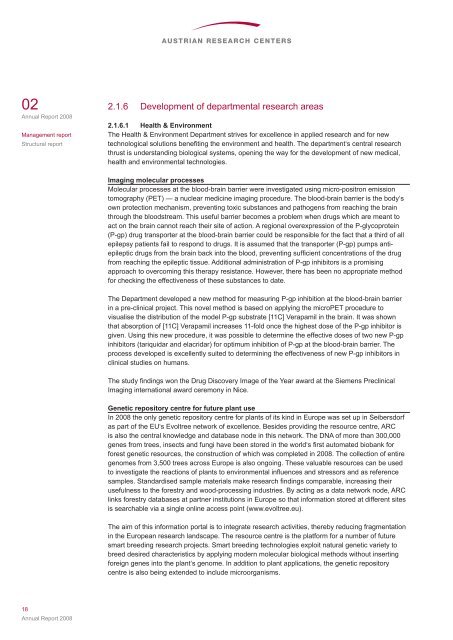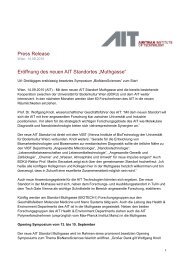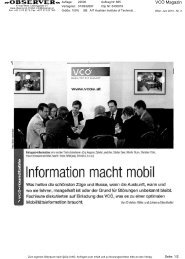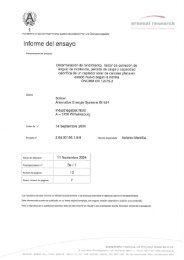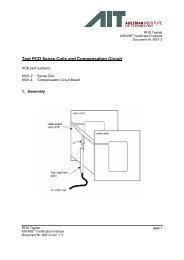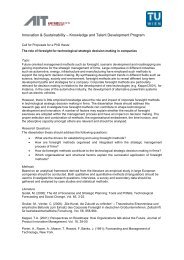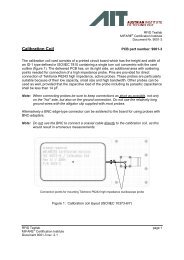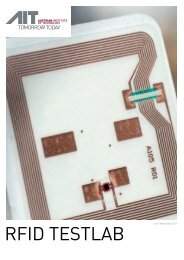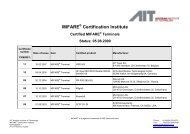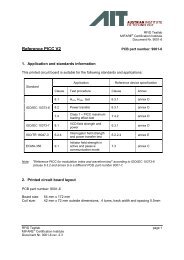Shareholders, Supervisory Board and management bodies ...
Shareholders, Supervisory Board and management bodies ...
Shareholders, Supervisory Board and management bodies ...
You also want an ePaper? Increase the reach of your titles
YUMPU automatically turns print PDFs into web optimized ePapers that Google loves.
02<br />
Annual Report 2008<br />
Management report<br />
Structural report<br />
18<br />
Annual Report 2008<br />
2.1.6 Development of departmental research areas<br />
2.1.6.1 Health & Environment<br />
The Health & Environment Department strives for excellence in applied research <strong>and</strong> for new<br />
technological solutions benefiting the environment <strong>and</strong> health. The department‘s central research<br />
thrust is underst<strong>and</strong>ing biological systems, opening the way for the development of new medical,<br />
health <strong>and</strong> environmental technologies.<br />
Imaging molecular processes<br />
Molecular processes at the blood-brain barrier were investigated using micro-positron emission<br />
tomography (PET) — a nuclear medicine imaging procedure. The blood-brain barrier is the body‘s<br />
own protection mechanism, preventing toxic substances <strong>and</strong> pathogens from reaching the brain<br />
through the bloodstream. This useful barrier becomes a problem when drugs which are meant to<br />
act on the brain cannot reach their site of action. A regional overexpression of the P-glycoprotein<br />
(P-gp) drug transporter at the blood-brain barrier could be responsible for the fact that a third of all<br />
epilepsy patients fail to respond to drugs. It is assumed that the transporter (P-gp) pumps antiepileptic<br />
drugs from the brain back into the blood, preventing sufficient concentrations of the drug<br />
from reaching the epileptic tissue. Additional administration of P-gp inhibitors is a promising<br />
approach to overcoming this therapy resistance. However, there has been no appropriate method<br />
for checking the effectiveness of these substances to date.<br />
The Department developed a new method for measuring P-gp inhibition at the blood-brain barrier<br />
in a pre-clinical project. This novel method is based on applying the microPET procedure to<br />
visualise the distribution of the model P-gp substrate [11C] Verapamil in the brain. It was shown<br />
that absorption of [11C] Verapamil increases 11-fold once the highest dose of the P-gp inhibitor is<br />
given. Using this new procedure, it was possible to determine the effective doses of two new P-gp<br />
inhibitors (tariquidar <strong>and</strong> elacridar) for optimum inhibition of P-gp at the blood-brain barrier. The<br />
process developed is excellently suited to determining the effectiveness of new P-gp inhibitors in<br />
clinical studies on humans.<br />
The study findings won the Drug Discovery Image of the Year award at the Siemens Preclinical<br />
Imaging international award ceremony in Nice.<br />
Genetic repository centre for future plant use<br />
In 2008 the only genetic repository centre for plants of its kind in Europe was set up in Seibersdorf<br />
as part of the EU‘s Evoltree network of excellence. Besides providing the resource centre, ARC<br />
is also the central knowledge <strong>and</strong> database node in this network. The DNA of more than 300,000<br />
genes from trees, insects <strong>and</strong> fungi have been stored in the world‘s first automated biobank for<br />
forest genetic resources, the construction of which was completed in 2008. The collection of entire<br />
genomes from 3,500 trees across Europe is also ongoing. These valuable resources can be used<br />
to investigate the reactions of plants to environmental influences <strong>and</strong> stressors <strong>and</strong> as reference<br />
samples. St<strong>and</strong>ardised sample materials make research findings comparable, increasing their<br />
usefulness to the forestry <strong>and</strong> wood-processing industries. By acting as a data network node, ARC<br />
links forestry databases at partner institutions in Europe so that information stored at different sites<br />
is searchable via a single online access point (www.evoltree.eu).<br />
The aim of this information portal is to integrate research activities, thereby reducing fragmentation<br />
in the European research l<strong>and</strong>scape. The resource centre is the platform for a number of future<br />
smart breeding research projects. Smart breeding technologies exploit natural genetic variety to<br />
breed desired characteristics by applying modern molecular biological methods without inserting<br />
foreign genes into the plant‘s genome. In addition to plant applications, the genetic repository<br />
centre is also being extended to include microorganisms.


